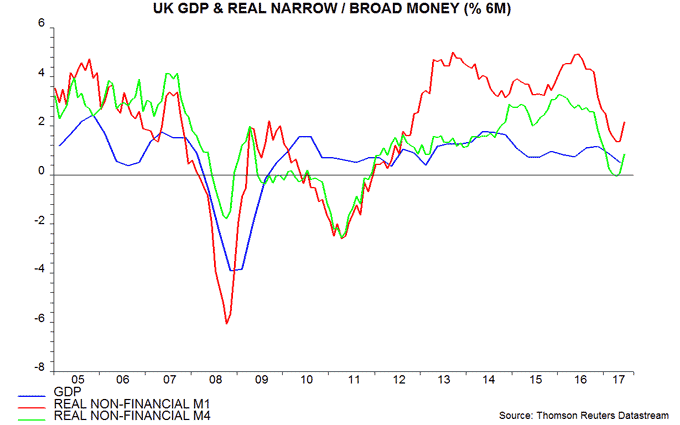Entries from August 1, 2017 - August 31, 2017
Global monetary backdrop still expansionary
Global narrow money trends are giving a positive signal for economic prospects in early 2018.
Six-month growth of real narrow money growth in the G7 economies and seven large emerging economies (the “E7”), adjusted to exclude a contraction and subsequent rebound in Indian M1 due to “demonetisation”, is estimated to have stabilised in July after rising between February and June, based on data covering two-thirds of the aggregate – see first chart.
An earlier fall in real money growth between August 2016 and February is expected here to be reflected in a near-term loss of economic momentum, following a strong first half. The rebound in real money growth since February, however, suggests that the economy will reaccelerate from late 2017.
Growth of the G7 plus E7 aggregate was supported in July by a rebound in Chinese expansion. US and Japanese growth eased back but continue to give a positive message – second chart.
The final July reading will be influenced importantly by Euroland / UK data to be released next week.
UK labour market report scores for MPC hawks
UK inflation and labour market data support the case for an early rise in interest rates, in the judgement here.
Headline and core consumer price inflation were unchanged at 2.6% and 2.4% respectively in July, against expectations of rises to 2.7% and 2.5%. Both are still heading higher, however, and the July results do not suggest an undershoot of the latest Inflation Report forecast.
Core prices (i.e. excluding energy, food, alcohol and tobacco), seasonally adjusted, have risen by an average 0.2% per month in the first seven months of 2017. The average increase over August-October 2016 was only 0.1% per month. A continued gain of 0.2% per month, therefore, would imply a rise in 12-month core inflation to 2.7% by October.
The headline / core gap, meanwhile, is likely to remain positive and may widen as food inflation – 2.9% in July, the highest since 2013 – rises further. CPI food inflation is unusually low relative to producer output price inflation of food products, of 5.8% in July.
With a rise from July’s 2.6% (2.63% before rounding) likely in August / September, headline inflation is on track to meet or exceed the MPC’s forecast of 2.68% in the third quarter in the August Inflation Report.
Today’s labour market report, on balance, scores for the MPC hawks. The Inflation Report predicted that the unemployment rate would fall to 4.4% in the second quarter and stabilise during the second half. The decline to 4.4% was delivered but the single-month estimate dropped to 4.2% in June, suggesting a third-quarter undershoot – see first chart.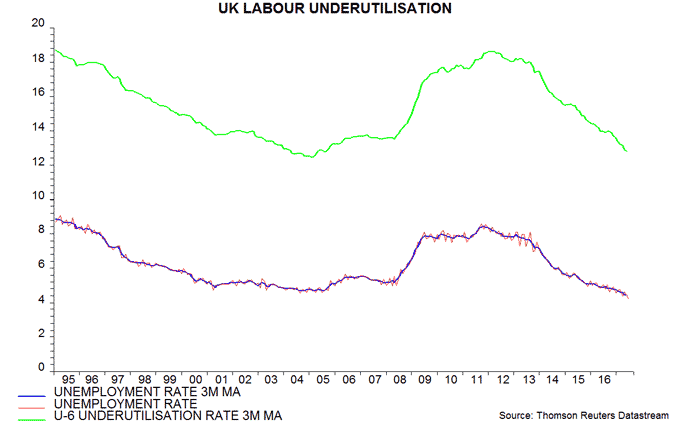
A wider measure of labour underutilisation encompassing involuntary part-time and discouraged workers continues to fall rapidly, reaching its lowest level since 2005 in the latest three months – first chart.
Earnings data surprised positively, with annual growth of total pay per employee firming to 2.1% in the three months to June from 1.9% in May (orginally reported at 1.8%).
For inflation control purposes, earnings growth should be assessed relative to productivity performance. Whole-economy output per hour fell by 0.1% in the year to the second quarter, according to a flash estimate also released today. Unit wage cost growth, therefore, appears to have moved above 2% last quarter.
Annual growth in aggregate earnings (i.e. average earnings multiplied by the number of employees) rose to 3.4% in the three months to June, as employment expansion remained solid at 1.2%. Aggregate earnings, therefore, continue to outpace consumer prices, supporting consumption prospects – second chart.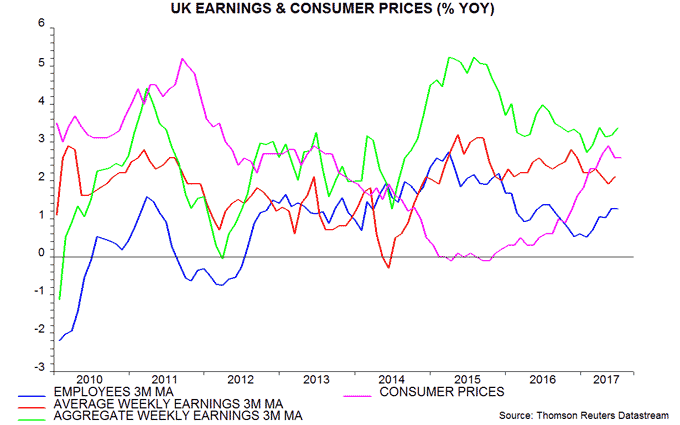
A minor weak point in the report was a fall in vacancies, suggesting that employment growth will cool during the second half – third chart. The decline, however, would need to extend to suggest a reversal of recent labour market strength.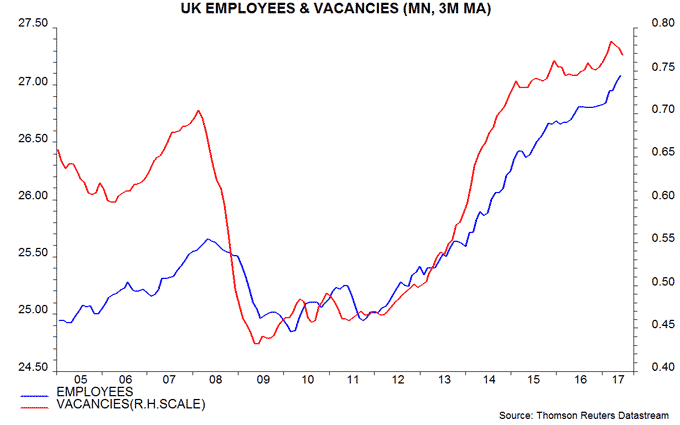
Chinese money trends suggesting economic resilience
A softening of Chinese economic activity data in July probably reflects pay-back for strong June results, as well as disruption from high temperatures / drought in parts of the country. Monetary trends suggest that economic growth will remain respectable during the second half.
Six-month growth of industrial output* reached a three-year high in June before falling back in July. The July reading, however, was close to the average since 2014 – see first chart.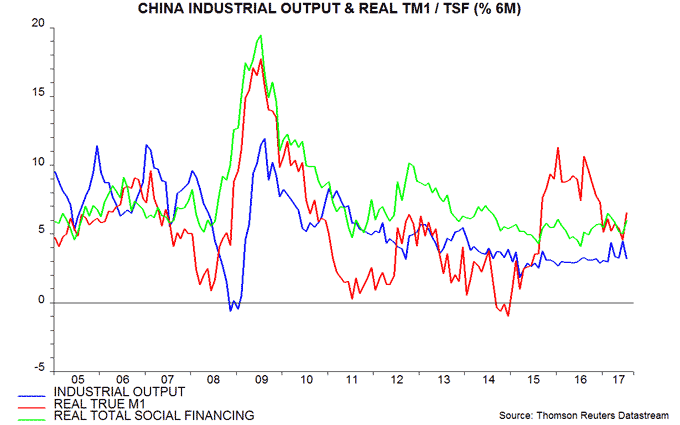
The preferred monetary aggregate for forecasting purposes here is “true” M1, comprising currency in circulation and demand deposits of corporations and households. (The official M1 measure excludes household deposits.) Six-month growth of real (i.e. consumer price inflation-adjusted) true M1 fell significantly between August 2016 and early 2017, suggesting softer economic momentum from the spring, allowing for an average nine-month lead. Growth, however, has remained above levels associated with economic weakness historically and rebounded in July – first chart.
Credit trends, meanwhile, appear consistent with the official aim of clamping down on speculative lending while maintaining "real economy" funding. Six-month growth of real total social financing of households and non-financial enterprises has fluctuated in a narrow range and was slightly above the average since 2014 in July – first chart. There has, however, been a significant slowdown in bank lending to financial institutions and government.
The rebound in six-month real true M1 growth in July reflected both a recovery in nominal expansion and a sharp decline in six-month consumer price inflation.
Pessimists argue that first-half policy tightening will exert an increasing drag on the economy during the second half. The rise in money market interest rates, however, has yet to feed through to a significant increase in bank lending rates – second chart. On the fiscal side, the central government deficit has been stable while annual growth in fixed asset investment in newly-started projects rebounded strongly in June / July – third chart.
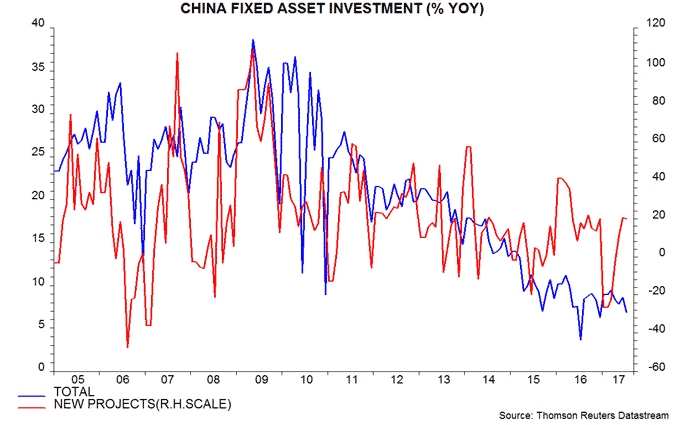
Money rates have subsided since June, with easing inflation and currency stability giving the PBoC scope to engineer a further decline, if necessary.
A constructive economic view will be maintained here barring a further slowdown in real true M1 growth.
Commentary on China is biased towards negativity, playing down or ignoring positive surprises. A recent rise in the NBS consumer expectations index to its highest level since 1993, for example, has received little attention – fourth chart.
*Seasonally adjusted series sourced from World Bank.
US banks turning expansionary, supporting economic optimism
The Fed’s July survey of bank loan officers supports the view here that the US economy is regaining momentum and may prove stronger than the central bank and consensus expect in late 2017 / early 2018.
The basis for this forecast is a sharp rebound in six-month growth of real (i.e. inflation-adjusted) narrow money from a low in February. Turning points in real narrow money growth have consistently led those in GDP growth in recent years – see first chart.
As previously discussed, the hypothesis here is that the fall in real narrow money growth in late 2016 / early 2017 and subsequent rebound mainly reflect the impact of reforms to money market fund regulations implemented in full in October 2016. The reforms prompted money funds to shift their portfolios out of bank deposits and financial paper into Treasury bills, resulting in a rise in banks’ funding costs in 2016 – second chart. Banks responded by reining in their balance sheet expansion, slowing money / credit growth. The net percentage of banks tightening loan standards (i.e. an average across various loan categories) rose to its highest since 2010 in July 2016 – third chart.

The adjustment of money funds’ portfolios, however, appears to have been completed by late 2016 and banks’ funding costs have normalised in 2017. Their behaviour, therefore, has turned more expansionary – the net loan tightening percentage fell further in the latest Fed survey to its lowest since 2015.
The money fund reforms acted as an effective tightening of monetary policy in 2016, resulting in the Fed having to raise rates by less than expected. The reversal of the drag this year is boosting the economy, outweighing restraint from the Fed’s three hikes since November 2016. The Fed may need to accelerate tightening to compensate.
The Fed survey loan tightening percentage, inverted, leads annual growth of real bank loans and leases, which stabilised in the second quarter – fourth chart. The six-month change in real bank loans has recovered from -0.3% (not annualised) in February to 0.7% in June, with weekly data indicating a further rise in July.
G7 core inflation decline may reverse in H2
A fall in G7 core* consumer price inflation since early 2017 has been driven by a sharp decline in the US. The US drop reflects a combination of a large cut in wireless telephone charges and normal volatility, with the latter suggesting a second-half recovery. Core inflation, meanwhile, may firm in Euroland and Japan, and remain elevated in the UK. A rebound in the G7 core rate coupled with economic reacceleration from late 2017 – suggested by monetary trends – could force faster-than-expected monetary policy tightening.
G7 headline consumer price inflation peaked at 2.0% in February and fell to 1.4% in June. The decline was mainly due to a reduced boost from food and energy prices but, in addition, core inflation subsided from 1.5% to 1.3% – first chart.

The core slowdown was driven by the US, where the core rate dropped from 2.3% in January to 1.7% in June. About one-third of this decline is attributable to a faster decline in wireless telephone charges – down by 13.2% in the 12 months to June versus 4.3% in January. Core inflation excluding such charges was 2.0% in June – second chart.

The remainder of the US core decline probably reflects normal volatility. The three-month change in core prices, seasonally adjusted and annualised, has fluctuated around a mean of 1.9% since 2005, with departures from this level usually short-lived and followed by an opposite deviation – third chart. (The exception was a sustained shortfall in the immediate aftermath of the 2008-09 recession.) The three-month change spiked up to 3.0% in February but has since reversed sharply lower, in line with the historical pattern but with weakness magnified by the cut in wireless charges.

The current low level of the three-month change, even excluding wireless charges, suggests that it will rebound to above the 1.9% average during the second half. A significant overshoot would push up the core annual rate (since core prices rose by an annualised 2.1% during the second half of 2016).
Euroland core inflation has firmed from 0.9% in December to 1.2% in July and may rise further as upward pressure from above-trend economic growth, reflecting earlier monetary strength, outweighs a drag from recent euro appreciation – fourth chart.

The Japanese core rate, meanwhile, may recover as a drag from yen strength into August 2016 is replaced by a boost from subsequent depreciation – fifth chart.
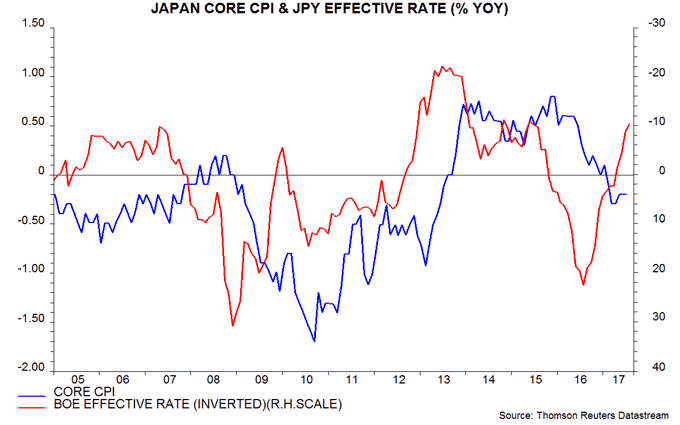
A recovery in G7 core inflation would probably push the headline rate back up, assuming that commodity prices of food and energy are stable at around current levels: the relationship with the annual change in commodity prices suggests that the headline / core gap will rise near term before turning slightly negative around year-end – sixth chart.
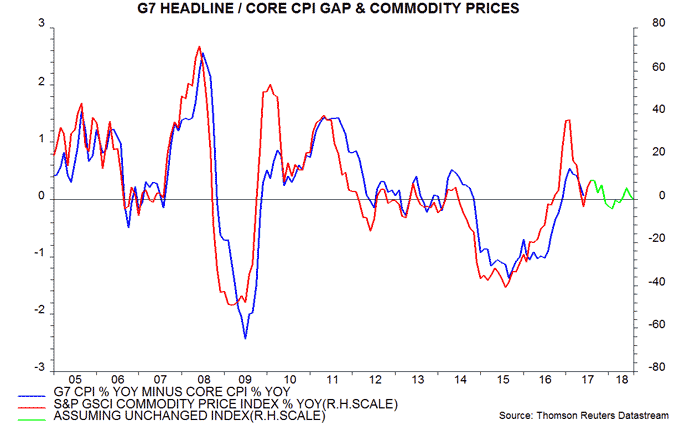
*”Core” = excluding food and energy. Japanese measure also adjusted for 2014 rise in consumption tax.
UK MPC more pessimistic about supply growth
A key take-away from the UK August Inflation Report is that the MPC has lowered its estimate of potential GDP growth to only about 0.4% per quarter. With the economy judged to be operating close to full capacity, a rebound in actual quarterly growth to above 0.4% could be sufficient to trigger an early rate hike.
GDP growth is now forecast at 1.7% in 2017 and 1.6% in 2018 versus 1.9% and 1.7% respectively in May. The downgrade partly reflects higher interest rates: the average level of Bank rate in 2018 implied by the market curve is 15 basis points higher than in May. Despite weaker growth, however, the three-year ahead inflation forecast is essentially unchanged – 2.22% versus 2.26% in May. Softer demand, in other words, is balanced by weaker potential growth.
The increased pessimism about supply-side potential is shown more clearly by inflation forecast based on an unchanged 0.25% Bank rate – the three-year ahead projection of 2.47% is up from 2.36% in May.
According to the latest policy statement, “GDP growth remains sluggish in the near term …” but “… picks up to just above its reduced potential rate over the balance of the forecast period”. GDP growth is projected at 1.8% at the end of the forecast so this suggests potential expansion of 1.6-1.7%, or about 0.4% per quarter.
The MPC expects quarterly GDP growth to remain at 0.3% in the third quarter before picking up slightly at the end of the year. A rebound to 0.5%, therefore, could be sufficient to persuade several more members to vote for an early hike.
Monetary trends are giving a more hopeful message for economic prospects: six-month growth of real narrow and broad money recovered significantly in June, reflecting a combination of stronger nominal expansion and a moderation of six-month inflation – see chart.